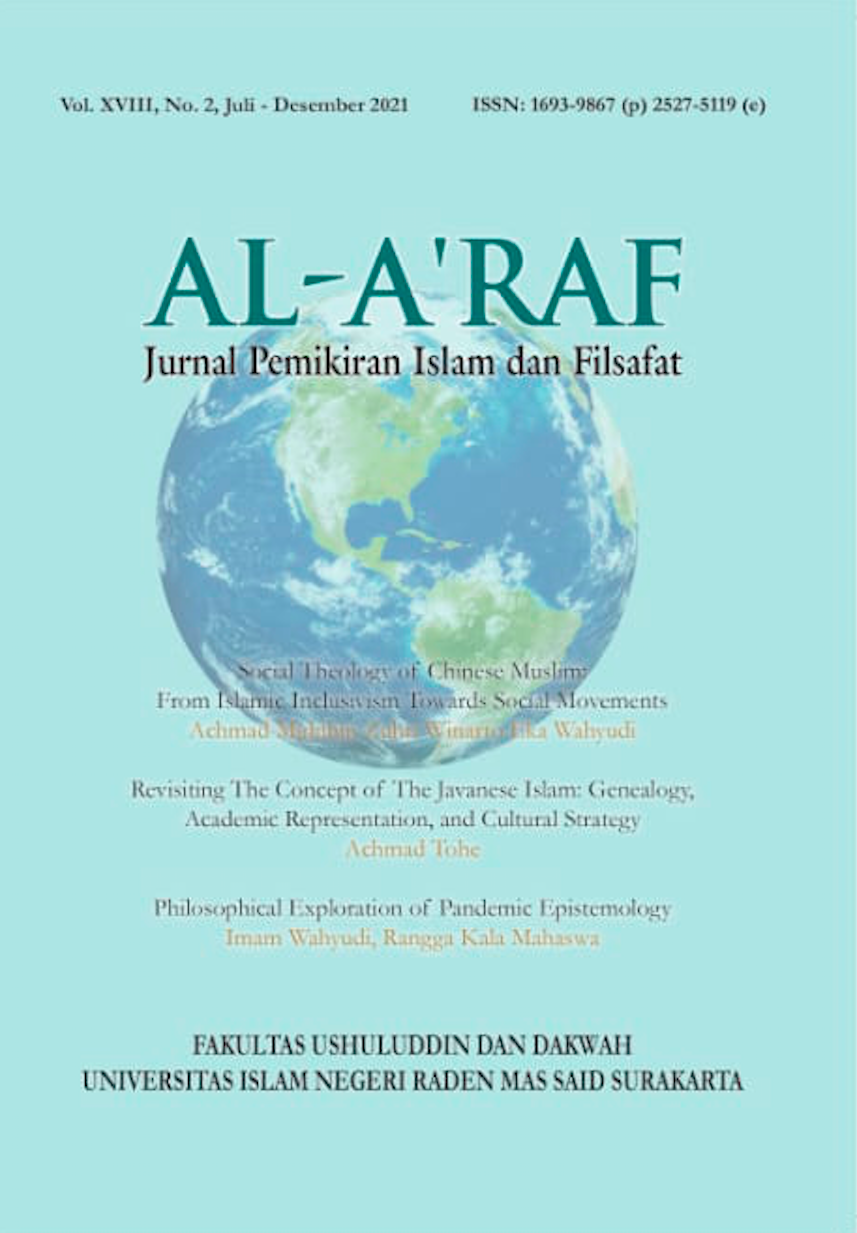Al-A'raf : Jurnal Pemikiran Islam dan Filsafat
Full Lenght Article
THE REFERENCE QUALITY AND CONTEXTUALITY OF ISLAMIC EDUCATION MATERIALS FOR THE ELEMENTARY SCHOOL
Abstract
Studies on the development of teaching materials have been dominated by a pedagogical orientation to develop learning objectives, strategies, and evaluation. Not many studies have been carried out on the scientific structure of teaching materials. This study tries to examine the relationship between Islamic education teaching materials in the sub-chapter of Al-Qur'an based on the authoritative Qur'anic exegesis. Studying Islamic education teaching materials from the reference sources aims to ensure the quality of the teaching materials. By focusing the study on analyzing the materials about the stories and models of the prophet Adam and Ayub, through the critical discourse analysis method on how the sources are used, and how the context of the material is presented, the results of this study reveal that the materials teaching of Islamic education, about the story of prophet Adam and Ayub, do not refer to the books of Qur'anic exegesis. The explanation model is textual. Partial values are provided, such as the repentance of the prophet Adam and the patience of Ayub. Therefore, this study recommended that the development of Islamic education teaching materials in the chapter of the prophet stories refer to the authoritative Qur'anic interpretation books so that the materials are richer, better in quality, and actual.
Keywords
Declarations
Publisher's Note
UIN Raden Mas Said Surakarta remains neutral with regard to jurisdictional claims in published maps and institutional affiliations.
References
Arafat, M. Yaser. “Analisis Antropologi-Struktural Kisah Musa dan Khidzir dalam Al-Qur'an.†Al-A’raf: Jurnal Pemikiran Islam dan Filsafat 15, no. 2 (2018): 233. https://doi.org/10.22515/ajpif.v15i2.1425.
Avivy, Ahmad Levi, Jawiah Dakir, and Mazlan Ibrahim. “Israiliyat Interpretive Literature of Indonesia: A Comparison between Tafsir Marah Labid and Tafsir Al-Azhar.†Mediterranian Journal of Social Sciences MCSER Publishhing 6, no. 3 (2015).
Bambang Sunan Giri, and Siti Rochmaida. Pendidikan Agama Islam untuk Kelas V SD. Jakarta: Pusat Kurikulum dsn Perbukuan Kementerian Pendidikan Nasional, 2011.
Fadriati. “A Model of Discovery Learning Based - Text Book of Character and Islamic Education : An Accuracy Analysis of Student Book in Elementary School.†JURNAL TA’DIB 20, no. 2 (2017).
Fahmi, Muhammad. “Pendidikan Islam Perspektif Fazlur Rahman.†Jurnal Pendidikan Agama Islam 2, No. 2 (2014): 273–98. https://doi.org/10.15642/jpai.2014.2.2.273-298.
Faisol, M. “Interpretasi Kisah Nabi Musa Perspektif Naratologi Al-Qur’an.†ISLAMICA: Jurnal Studi Keislaman 11, no. 2 (2017): 365–92. https://doi.org/10.15642/islamica.2017.11.2.365-392.
Fikri, Luthfi Khairul, Wahyu Wibisana, and Munawar Rahmat. “Perkembangan Pendidikan Agama Islam (PAI) di Sekolah Dasar Tahun 1945-1966.†TARBAWY : Indonesian Journal of Islamic Education 2, no. 2 (2015): 172. https://doi.org/10.17509/t.v2i2.3454.
Hadi, Sopyan. “Konsep Sabar Aalam Al-Qur'an.†Jurnal Madani: Ilmu Pengetahuan, Teknologi, dan Humaniora, 2018. https://doi.org/10.33753/madani.v1i2.25.
Hamka. Tafsir Al-Azhar. Singapura: Pustaka Nasional, 2003.
Hanik Yuni Alfiyah. “Aplikasi Paradigma Konstruktivistik Model Kooperatif STAD untuk Meningkatkan Kualitas Pembelajaran PAI di Kelas IV SD Taruna Surabaya.†Jurnal Pendidikan Agama Islam 02, no. 02 (2014): 234–72. https://doi.org/10.15642/jpai.2014.2.2.233-272.
Hasbiyallah, Muhammad. “Paradigma Tafsir Kontekstual: Upaya Membumikan Nilai-Nilai Al-Qur'an.†Al-Dzikra: Jurnal Studi Ilmu Al-Qur’an dan Al-Hadits 12, no. 1 (2018). https://doi.org/10.24042/al-dzikra.v12i1.2924.
M. Quraish Shihab. Tafsir Al-Mishbah, Pesan, Kesan, dan Keserasian Al-Qur'an. Jakarta: Lentera Hati, 2007.
Manna’ al-Qathan. Mabahits fi ’Ulum Al-Qur'an. Riyadh: Mansyurat al-’Ashr al-Hadits, 1973.
Matswah, Akrimi. “Pendekatan Kritik Naratif A.H. Johns terhadap Narasi Dialog dalam Surah Yusuf.†SUHUF Jurnal Pengkajian Al-Qur’an dan Budaya 11, no. 1 (2018): 145–62. https://doi.org/10.22548/shf.v11i1.308.
Mughis, Abdul, Syamsul Arifin, and Syamsudin Lubis. “Analisis Isi Kurikulum PAI dan Kemampuan Dasar Siswa Kelas III SDN Kelapa Gading Timur Jakarta Utara,†n.d.
Mustaqim, Abdul. “Kisah Al-Qur'an: Hakekat, Makna, dan Nilai-Nilai Pendidikan.†Ulumuna; Jurnal Studi Keislaman 15, no. 2 (2011): 29. https://doi.org/10.20414/ujis.v15i2.199.
Natsir, M. “Pengembangan Pembelajaran Fikih Kelas X Madrasah Aliyah dalam Model Dick & Carey.†Jurnal Pendidikan Agama Islam 5, no. 1 (2017): 44. https://doi.org/10.15642/jpai.2017.5.1.44-67.
Sahiron Syamsuddin. Hermeneutika dan Pengembangan Ulumul Qura'an. Yogyakarta: Pesantren Nawesea Press, 2017.
———. Tafsir Studies. Yogyakarta: eLSAQ, 2009.
Sanaky, Hujair AH. “Reserach and Development Bahan Ajar Pendidikan Agama Islam di Sekolah Dasar Luar Biasa Tuna Grahita Ringan (C) SLB Bhakti Kencana Berbah Sleman Oleh Hujair AH. Sanaky Dkk.†Millah XIII, no. 2 (2014). https://doi.org/DOI: https://doi.org/10.20885/millah.vol13.iss1.art4.
Sekar Galuh Endah Pinuji Lawuningrum, and Nurwahid. Pendidikan Agama Islam untuk Sekolah Dasar Kelas IV. Jakarta: Pusat Kurikulum dsn Perbukuan Kementerian Pendidikan Nasional, 2011.
Sitti Jauhar. “Pengembangan Bahan Ajar IPS Berbasis Pendekatan Sains Teknologi Masyarakat (STM) untuk Meningkatkan Kreativitas Siswa di Sekolah Dasar.†JIKAP PGSD-Jurnal Ilmiah IlmuKependidikan 2, no. 2 (2018).
Untung, Syamsul Hadi, and Achmad Idris. “Telaah Kritis Terhadap Hadis Misoginis.†KALIMAH 11, no. 1 (2012): 38. https://doi.org/10.21111/klm.v11i1.483.
Copyright and permissions
This work is licensed under a Creative Commons Attribution-NonCommercial 4.0 International License.



